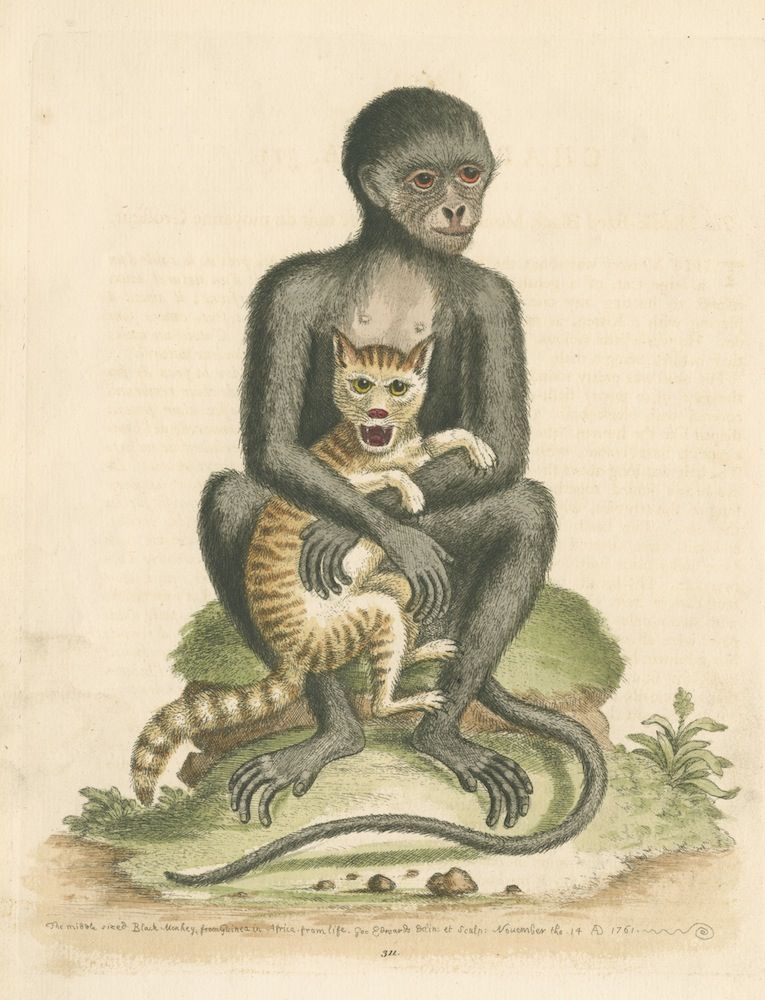12 Days of Science: Celebrating Christmas with Cool Images

On the first day of Christmas, my true love gave to me ... One cuddly monkey. The British Royal Society is highlighting its picture archive with a release of science illustrations for the 12 days of Christmas. This monkey snuggling a kitten came from "Gleanings of natural history, exhibiting figures of quadreupeds, birds, insects, plants, &c..." by naturalist George Edwards, published in 1764. Of the monkey, Edwards wrote:
"This Monkey was about the size of a large Cat, of a gentle nature in respect of hurting anyone. He loved playing with a Kitten, as most Monkies do...The Cat is added only to decorate the figure... I am informed he is a native of Guiney, on the coast of Africa. He was a very active, lively, diverting good-natured animal: but I was obliged to part with him for want of convenient room...I presented him to a right honourable Lord in Essex, who had a convenient menagery..."
(Image credit: © Royal Society)Forget partridges in a pear tree or lords a-leaping. The British Royal Society, the world's oldest scientific society, is celebrating the 12 days of Christmas with gorgeous science illustrations from its picture library.
From a monkey cuddling a kitten to 12 stunning (no pun intended) jellies, the images explore different facets of biology, ornithology and geology. In place of five golden rings are five pink rings surrounding a portrait of Sir Tim Berners-Lee, an Internet visionary and professor at MIT. (The rings represent a "map" of the Web.)
Some of the illustrations portray more fantasy than science. Instead of eight maids a-milking, a woodcut from 1582 portrays "eight beasts in battle" — actually four panels of an imagined (and unlikely) showdown between a rhinoceros and an elephant. And the winner is: "the Rhinoceros ... enemy of the Elephant, sharpens his horn against a rock, and valiantly goes into battle against him ... killing the Elephant."
Other images explore human nature. On the ninth day of Christmas, The Royal Society celebrates "nine fireman leaping" with an 1825 illustration of Russian firefighters practicing rescue techniques on a spindly looking scaffolding. On the third day comes an illustration of three Inuit in a group portrait sketched by Capt. James Clark Ross, who was icebound in the Canadian Arctic for four winters.
The illustrations are available year-round at The Royal Society picture library and will be highlighted day-by-day, starting on Christmas Day, on The Royal Society Facebook page. Traditionally, the 12 days of Christmas start on Christmas Day or the day after and extend to the day before the Feast of Epiphany, or Three Kings' Day, a Christian holiday that celebrates the manifestation of Jesus as a divine being.
Follow Stephanie Pappas on Twitter and Google+. Follow us @livescience, Facebook & Google+. Original article on Live Science.
Sign up for the Live Science daily newsletter now
Get the world’s most fascinating discoveries delivered straight to your inbox.

Stephanie Pappas is a contributing writer for Live Science, covering topics ranging from geoscience to archaeology to the human brain and behavior. She was previously a senior writer for Live Science but is now a freelancer based in Denver, Colorado, and regularly contributes to Scientific American and The Monitor, the monthly magazine of the American Psychological Association. Stephanie received a bachelor's degree in psychology from the University of South Carolina and a graduate certificate in science communication from the University of California, Santa Cruz.












